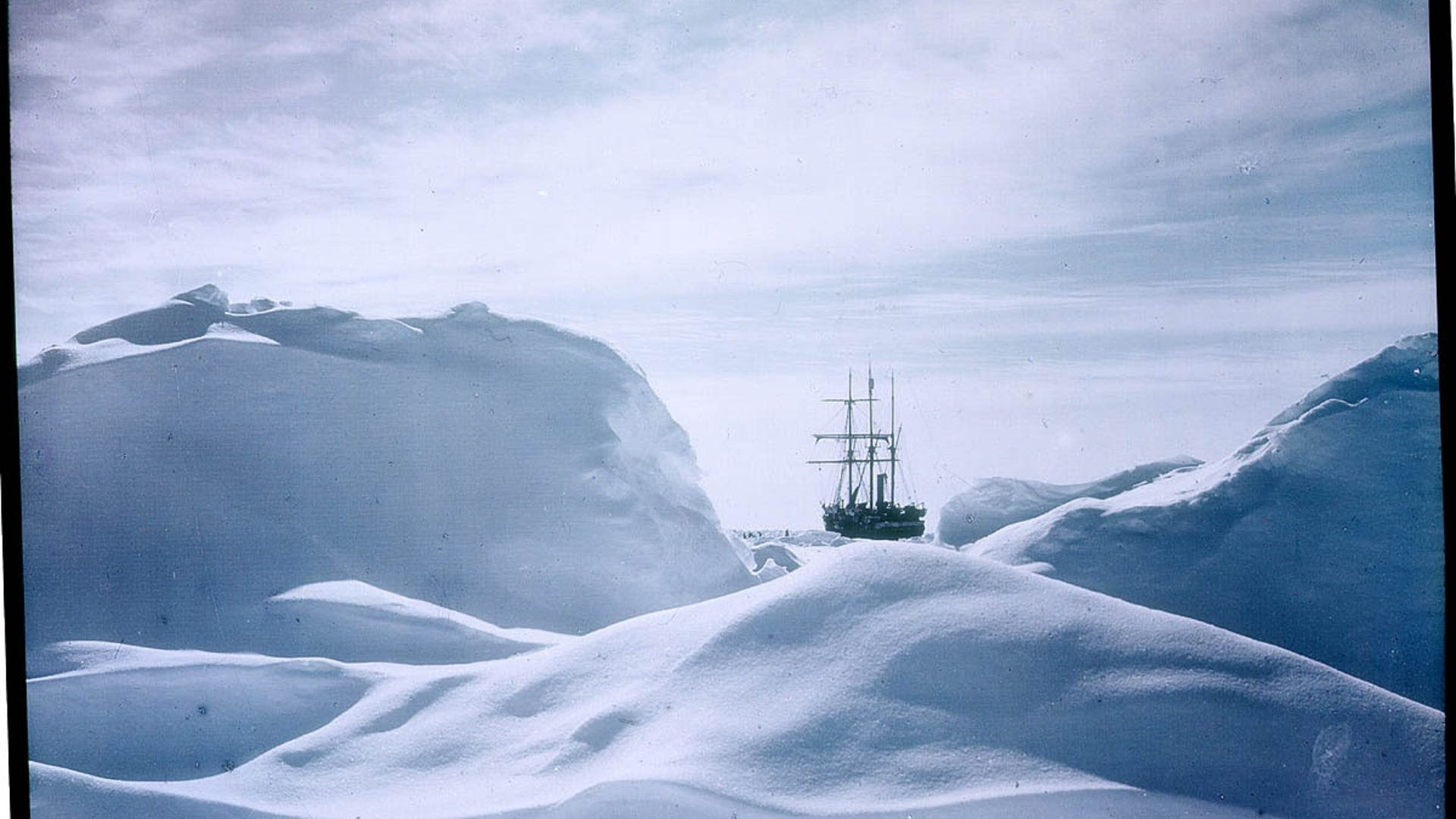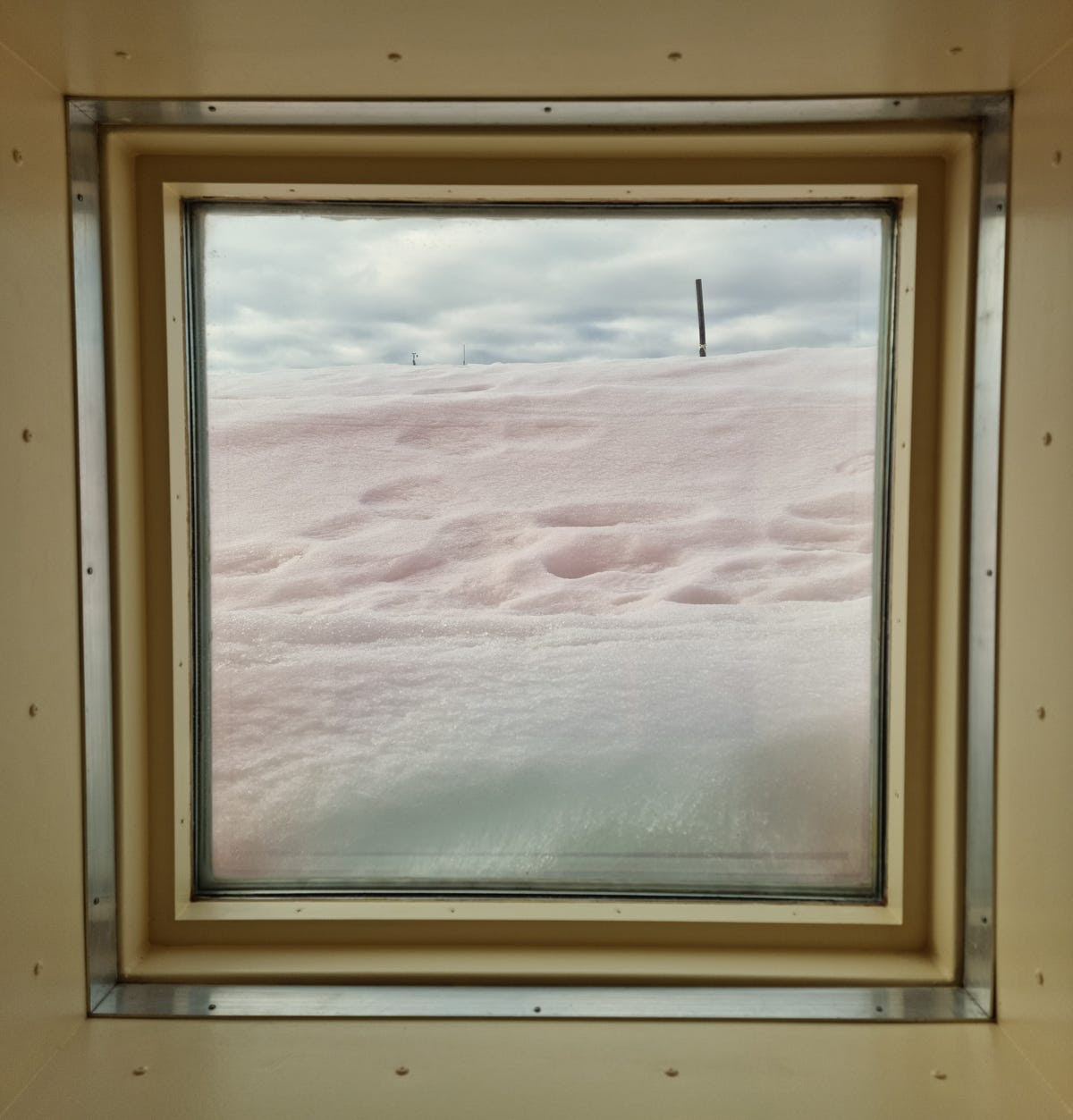

Will The Ghosts of Antarctica Haunt The World Over
AS THE WHALING ship Hope rounded Chile’s Cape Horn in September 1840, a tempest stirred. Winds drove the vessel toward a vast field of sea ice. As night fell, the Hope became surrounded by frozen castles rising out of the Southern Ocean, forming an inescapable labyrinth. Thick islands of ice collided with the hull, threatening to ensnare the ship in a wintry grip, crushing it like a boa constrictor around a mouse.
It wasn’t until dawn the next day, when the cruel winds had died down, that a full accounting of the night’s terrors could be made. Miraculously, the Hope had survived. The castles that once surrounded it had fallen, replaced by mere slabs of disintegrating ice.
As the ship made its way through the ice, a shout came from the crow’s nest: A sailor had spotted a schooner, laid up against an iceberg. Through the spyglass, it was as if the ice had invaded the ship. The Hope approached cautiously. To the crew, it seemed the derelict schooner had been abandoned. The captain of the Hope, a man named Brighton, lowered a boat and sailed toward the berg-bound ship with three sailors. As they rounded the aft, faded lettering came into view: Jenny. They climbed aboard, each step eliciting a wretched groan. The sailors shouted down into its bowels, hoping for signs of life, but received no response. Then they descended.

Mitchell Library, State Library of New South Wales
As they stepped into the cabin, they were startled by the sight of a corpse. A man, frozen stiff. He sat in a chair, at a table, with a pen still gripped by blackened fingers. In front of him lay a logbook recounting the tale of the Jenny’s final days. It revealed that the schooner had been beset by ice in November 1822 and become trapped — a fate the Hope had only narrowly avoided itself. The crew of the Jenny had drifted across the sea, desperately fighting to break free of the ice. A futile endeavor; as impossible as sailing a ship to the moon. The Jenny’s captain had kept the fire in the cabin burning for 72 days.
But, the logs showed, on day 73 the fire went out.
Will The Ghosts of Antarctica Haunt The World Over
A FIRE IS raging.
In December 2019, the Sydney Harbour Bridge is blanketed by an ochre curtain of muck. Smoke from out-of-control bushfires burning tens of kilometers away has shrouded the city. It’s an unforgettable sight, but the smoke invades all the senses differently. I can, for the first time, taste climate change. It’s ash and soot and heat and illness. I can feel it settle in my lungs as I inhale. I feel it again when I cough up the ash into a balled fist on the train home.
I struggle to kick the image of the “This is fine” dog out of my head throughout the summer. The animated dog, star of countless internet memes, sits in a room engulfed by flames. The room fills with smoke. Everything begins to melt. It refuses to do anything about it. The dog merely chimes “This is fine,” sips on its coffee and sublimates. Its eyeballs begin to seep out of its head.
Two years later I’m reclining on a moss-free rock at the very edge of the end of the world, just a few kilometers east of Australia’s Casey Station in Antarctica. I can hear the distant squawking of Adelie penguins and, occasionally, the splash they make as they porpoise across the surface of the water. The faint smell of guano flitters in and out of my nostrils when the wind switches direction. I’ll take that over ash any day.
The sound of the Adelies eventually makes way for a steady, rhythmic dripping. From my rocky seat, just meters from the water’s edge in Newcomb Bay, I can hear the continent slowly disappearing into the ocean. Drip. This, I’m later told by a member of the station, is a routine sound during the Antarctic summer. Sit and listen long enough and you’ll hear the ice melting; hang around and you’ll see rock-strewn hills emerge from layers of snow as the sun beats down. This isn’t climate change you’re hearing and seeing. Drip. Isn’t it?
Deeper inland from Casey, the East Antarctic ice sheet rests mostly undisturbed, except for a few international installations. Drip. Locked up within the sheet is “tens of meters” of sea-level rise, according to Matt King, an ice sheet scientist at the University of Tasmania. If the whole thing were to melt, the results would be disastrous. Drip. Some of the world’s most famous cities would drown. Drip. There’s no danger of that happening anytime soon, but the East Antarctic ice sheet has received far less attention than the West. We’re only just beginning to find out how vulnerable it might be. There remain many “unknown unknowns,” King says. Drip.
As I listen to the steady melt, my mind wanders back to the “This is fine” dog, to the scorched air of a burning country. I pull my hood over my forehead, zip my jacket up over my chin and drift off.
THE DRIFT OF the Jenny in the Antarctic ice is, as far as I can tell, a ghost story. Unsubstantiated reports received widespread attention in the German press during the early and mid 19th century. According to an anonymous article first printed in an 1862 edition of Globus, the account could not be verified by eminent maritime shipping record-keeper Lloyd’s. So the Jenny was, most likely, not a real ship. It was an urban legend, whispered by sailors who had battled the violent swells of the Drake Passage and won.
The story of the ice ship offers a glimpse into what confronted those who ventured toward the bottom of the Earth during the early days of Antarctic exploration. Our first recorded sightings of the continent are from 1820, just a few years before the supposed disappearance of the Jenny, but it was decades before men (and it was always men, as women were not allowed on expeditions) set foot on the continent itself. It was several decades more before they trekked inland and longer still before they planted flags at the South Pole.
Antarctica’s most celebrated era, the Heroic Age of exploration, kicked off in the late 19th century. It was a time draped in a mythology of misery and death, as much as it was a springboard for fantastic tales of brave men overcoming insurmountable odds. The real expeditioners who made their name at the end of the world — Robert Falcon Scott, Roald Amundsen, Ernest Shackleton — battled the same hardships the fictitious Jenny did.
These were plucky bands of Davids facing off against an unbending glacial Goliath. The latter often prevailed. In total, 22 men died during the Heroic Age, which lasted from 1898 to 1922. On rare occasions, expeditioners limped back, skeletal and frostbitten, but without a casket for a fallen comrade.
Shackleton’s Endurance expedition of 1914 is the most famous example. Shackleton’s ship became imprisoned in the ice for months until, with several thunderous booms, it was crushed, its masts slowly sinking beneath the ice in the Weddell Sea. For more than a century, it remained undiscovered. Another ghost story.

Mitchell Library, State Library of New South Wales
In the last century, we’ve completely reversed this relationship. We are Goliath, with total dominion over the bottom of the world. We’ve muddied the fringes of the continent under the guise of science, building bases that guzzle a special diesel blend, our tourist ships and science voyages blacken the continent’s snow leading to ever-faster melting, and barrels of toxic oil remain buried under the snow just a short hop from Casey Station, leaking metals into the soil.
We’re writing ghost stories in real time. Watching. Waiting for collapse.
AN ICE SHELF is collapsing.
On March 15, 2022, an ice shelf the size of Rome disintegrates before our eyes. Images from satellites begin to filter in. One day, a white sheet is draped over the ocean, the next it has burst into a million pieces. A ghost, within a matter of days.
In the weeks preceding the collapse of this ice shelf, East Antarctica experienced the most extreme heat on record. At Concordia Station, temperatures soared above the March average by almost 40 degrees Celsius. It was warm enough for scientists to don their togs and beach gear. Andrew Mackintosh, a climate scientist at Monash University, told me at the time that scientists couldn’t say for certain if the collapse of the shelf, which was named Conger, was connected to the warming event but that the timing seemed to line up. “The ice shelf may have been thinning over time,” he noted, “and the warming may have been the final hammer blow.”
Antarctic scientists blamed the extreme heat on an “atmospheric river” — that wasn’t a phrase I had ever needed to understand before carbon dioxide concentrations tipped over 420 parts per million — but were quick to point out that the glaciers and ice sheet in the East would suffer no major damage in the short term. This was an anomalous event.
However, it would take months or years to understand the long-term impacts in some areas. Felicity McCormack, a glaciologist at Monash University, studies the Vanderford glacier, which lies close to Australia’s Casey Station. She said that it would be hard to predict what the long-term impacts on that glacier would be but that the region experienced a huge amount of snowfall, so we might expect to see “dynamical impacts” into the future.
On the opposite side of the continent, across the Antarctic Peninsula, temperatures are rising faster than anywhere else in the Southern Hemisphere. When the global average temperature has risen by 1.5 degrees Celsius since preindustrial times — as it will certainly do in the coming decades, according to the Intergovernmental Panel on Climate Change — this region of the Antarctic will start to experience irreversible changes. Glaciers will retreat. In fact, they already are retreating. Temperatures will enable nonnative species to take hold, disrupting unique ecosystems. The sea ice, a valuable source of nourishment for keystone species like Antarctic krill, will have diminished exponentially. By 2100, the Antarctic Peninsula may be unrecognizable.
In just one human lifetime, we’re completely changing the planet.
Will The Ghosts of Antarctica Haunt The World Over
CAN YOU BE haunted by ghosts that don’t even exist yet?
Drip.
WHEN PLUNGED INTO freezing cold water, the human body immediately seizes up. Receptors in the skin sense the abrupt change in temperature and, involuntarily, the lungs gasp for air and quickly fill with water. An increase in heart rate and blood pressure occur nearly simultaneously. These unconscious reflexes can quickly incapacitate the body.
It was a bespectacled South African doctor, Clive Strauss, who lectured me about this phenomenon — the “cold-shock response.” I’d been selected to journey to Antarctica in December 2021 aboard the RSV Nuyina, the Australian Antarctic Division’s new $529 million icebreaker. To get on board, I’d had to endure 15 days of quarantine and brutal online training — these usually involved an hour-plus stuck in poorly buffering calls on Microsoft Teams as PowerPoint presentations joylessly flicked from one slide to the next, detailing the strict policies, procedures and responsibilities of an Antarctic expeditioner.
Strauss’ presentation was an outlier. It crackled along through my monitor in Bad Internet Low Resolution, detailing a nightmarish list of maladies that might befall an expeditioner. In a matter-of-fact tone, he moved from frostbite (images of blackened, snarled fingers) to snow blindness and what to do if you get an icepick through the leg (that slide was labeled with a warning: “DO NOT pull it out!”). Of course, he explained cold shock, too, with unflinching honesty: If you were to fall into the Southern Ocean, you’d be dead in less than half an hour.
I can hear Strauss’ voice every time I stare over the edge of the Nuyina and gaze into its wake. I recognize, in those moments, how ill-suited my body is for the frigid chill of the Southern Ocean. But the ocean is warming. While it will never reach temperatures suitable for humans to dive into or frolic in, incremental warming of even a few degrees will irrevocably alter the kingdom underneath the waves.
Though the Southern Ocean is home to the largest creature on Earth, the blue whale, it’s the diminutive Antarctic krill that reign supreme. These six-centimeter-long crustaceans look a little like translucent prawns and, though individually tiny, can swarm in the billions. It’s estimated that more than 300 trillion krill call the Southern Ocean home, and their kingdom extends over a region five times larger than the US. They’re a keystone species of the south, providing the major food source for Antarctic megafauna such as whales, seals and penguins.

Climate change presents two problems for these creatures. Over millennia, they’ve learnt to respond to the Antarctic’s two seasons. In the summer months, they build up fat reserves by feasting on microscopic algae blooms. By winter, they utilize those stores, shrinking in size. This is all timed by an internal metabolic clock honed through evolution. “They’re perfectly adapted to the boom and bust of the Antarctic ecosystem,” says Rob King, a krill biologist at the Australian Antarctic Division.
As the ocean warms, the sea ice is retreating earlier. The algal blooms are flourishing sooner. But the krill’s metabolism doesn’t seem to be adaptive to these changes, King notes. In addition, the ocean is becoming more acidic as it draws down the excess carbon dioxide humans have pumped into the atmosphere. In laboratory settings, high levels of carbon dioxide, in accordance with the highest levels projected by the IPCC, proved fatal for krill larvae.
If the krill go, so too the whale. So, too, the penguins and the seals. The whole food web collapses. An ocean of ghosts.
HOW WAS IT?
When you return from Antarctica, everybody asks this question. It comes over coffee, as knives clink against plates, via Slack messages or on the Zoom meetings you’d become accustomed to missing. It’s a reasonable question, don’t get me wrong, but it’s impossible to truly answer.
Do I tell them that visiting Antarctica has seeded an existential crisis about the future of the planet? That I’m worried about the things we’re going to lose, about the ghosts we’re going to create? Do I tell them that I constantly ask myself what it really means to travel to Antarctica on board a diesel-electric icebreaker with a million liters of fuel in its belly? Do I explain how the very vessel that carried me to my destination, in its own small way, will contribute to the demise of that destination?
It’s at night, as I slide along my bunk with the rocking of the Nuyina, that I run through these questions. Some nights I’m up late trying to write stories about the ghosts that don’t even exist yet. Images of the Jenny and the Endurance flash through my mind’s eye. I see a billion krill swarming through an ocean thick with acid and expiring. I picture glaciers I don’t even know the name of melting away in months, the ice disappearing — Drip. Drip. Drip. — then collapsing.

“How was it?”
“Well, it was …”
One evening, as the Nuyina sails home, I’m sitting at my laptop with the empty page of a Google Doc open. Taunted by the intermittent flash of the cursor. I want to fill the page with these ghosts. At 1:30 a.m., I’ve made no progress and I notice, outside my cabin, someone squeaking down the corridor. They must be in big, wet boots. They move from one end of the ship to the other and back again. I groggily stumble across to my cabin door and poke my head out.
The halls are empty. The ship winces against the waves. Nobody’s there. I close my laptop and climb into my bunk, letting the ship rock me to sleep.
“How was it?” they ask.
“It was haunting,” I want to say. “I swear I heard a ghost.”
Will The Ghosts of Antarctica Haunt The World Over










